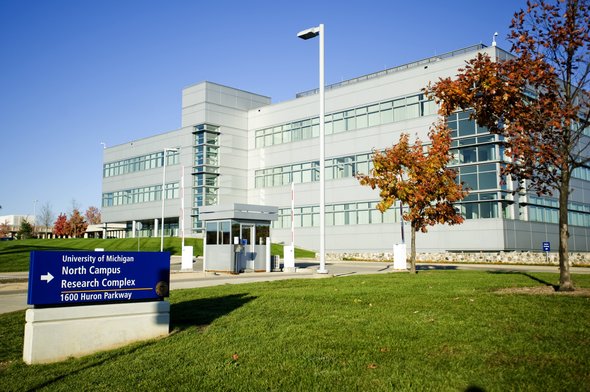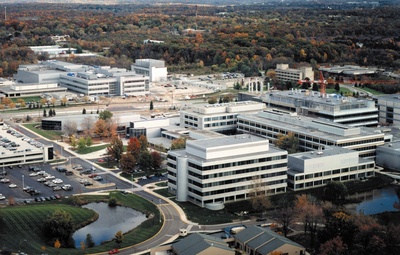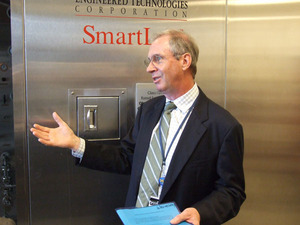North Campus Research Complex after 3 years and $200M: 'Are we making the most of the opportunity?'

The University of Michigan bought the Pfizer property at 1600 Huron Parkway in Ann Arbor three years ago. It will have invested $300 million in the facility over a six year period.
AnnArbor.com file photo
In fact, the dean of the University of Michigan medical school was quite the opposite, leading a contingent of college officials that thought purchasing the 2.2-million-square-foot Pfizer complex was a smart, albeit aggressive, move.
The 28-building, 174-acre complex was a gamble to be sure: Normally you have enough staff to fill a building, and a stated need for a facility, before the facility comes along. And while the medical school was pinched for space, there were hardly — and still aren't — enough existing bodies or uses to fill the complex.

The former Pfizer complex
"When the university typically builds a building, it pretty much has all the occupants in mind for the building so that when the building opens, it's pretty full," explained David Canter, executive director of the North Campus Research Complex. Canter led the site when it was under the ownership of pharmaceutical company Pfizer. "NCRC represented a very different strategy. ... We didn't have all the occupants lined up and it was seen as a completely different way of working.
"We took a risk," he continued.
The outcome, U-M officials have since surmised, turned out to be well worth the risk; and now the conversation over NCRC has turned tide.
"The risk is not seen as a such a risk anymore, now it's seen as 'are we making the most of the opportunity?' " Canter said.
University President Mary Sue Coleman said recently that she considers the acquisition of the Pfizer complex one of the top accomplishments of her tenure, which began in 2002.
"Universities never have the chance to purchase 2.2 milliion square feet of space and all this land at pennies on the dollar," she said. The complex sat untouched on the market for a full two years after Pfizer's closure and was losing value.
When U-M first acquired the complex in June 2009, Vice President for Research Stephen Forrest called it "a way to re-envision actually how the University of Michigan does research fundamentally."

Gov. Rick Snyder and the University of Michigan's Stephen Forrest during the June 21 Entrepreneurs Engage "unconference" at the University of Michigan North Campus Research Complex.
Angela J. Cesere | AnnArbor.com
In a recent interview, Woolliscroft said the acquisition allowed U-M faculty and administrators to "think differently."
"For the first time in our history we had sufficient space. Space wasn't a limiting factor. When space is the limiting factor then you're very reluctant to use it for more experimental relationships and collaborations," he said. "In some ways it’s the coffee pot. [NCRC] is allowing people to bump into one another."
Center spawns institute
As NCRC marks its third year, the complex has reached a new milestone: It has spawned its first institute, one that includes economists, public health researchers, engineers, medical researchers and behavioral scientists.
The Institute for Healthcare Policy and Innovation has set up shop in NCRC, bringing 400 existing university faculty and researchers together to create a nucleus of health care research in Ann Arbor.
Officials are hoping that NCRC can facilitate the key ingredient necessary to make the institute a success: collaboration. It's an ingredient that's been missing from efforts at Duke and Harvard universities, creating failures in innovation, says interim institute director Rod Hayward.
"A lot of unviersities have tried to do this," Hayward said in an interview with AnnArbor.com. "There's all of these successful investigators doing their own thing. To get them to [collaborate] with other individuals ... can be hard."
The institute's success, he added, will hinge on making sure the barriers to collaboration are minimal, researchers are using the space well, having seminar series that are top-notch and that bring people together for discussion and interaction, and establishing best practices for submitting grants.
The number of research grants U-M received in 2011 is down from the number received in 2010, recent budget figures show.
Woolliscroft said that the institute would "absolutely not" exist if U-M did not purchase NCRC: "Without NCRC we wouldn’t have even been thinking along those lines."

David Canter, executive director of the University of Michigan's North Campus Research Complex, said the ex-Pfizer site will be at capacity earlier than expected.
AnnArbor.com file photo
$300 million over six years
Since the $108 million purchase of the complex, the university has put nearly $92 million in additional investments into NCRC, including construction projects and yearly operating costs.
The university is spending $13.7 million to renovate a 120,000 gross-square-foot NCRC building for health services research and is planning to renovate or repair 10 additional NCRC buildings by the end of 2013. Other costs that are difficult to quantify include administrative support surrounding NCRC, faculty recruitment efforts and the overall operation of a expanded research enterprise.
In the next three years, the university expects to invest another $100 million in NCRC, bringing the tab to $300 million.
When the university chose to purchase NCRC, the medical school agreed to pay operating costs for the complex's first 10 years, Woolliscroft said.
Today, the complex costs roughly $18 million a year to operate, including utilities and maintenance but not accounting for faculty salaries or administrative support.
Those costs are shouldered by each of the medical school departments and centers, including ones that don't currently use NCRC space.
Woolliscroft called the cost sharing a "tax that each of the departments have imposed on every faculty member," but said that in his experience faculty made the sacrifice willingly because "what's in all of their interests is to enhance ... the standing of the medical school."
Other departments and schools that use NCRC space also contribute toward operating costs.
Isolated from Central Campus
When Woolliscroft began advocating U-M's purchase of the old Pfizer complex, one of his platforms was the proximity of NCRC to existing university property. The complex is adjacent to North Campus and, as Woolliscroft puts it, 100 years from now when the NCRC buildings are outdated, the property could provide "wonderful flexibility and opportunities for the university" to expand.
But while NCRC is close to university property, it's far from the active and heavily populated Central Campus and Medical Campus and some faculty have been reluctant to trade the buzz of campus life for more isolated NCRC quarters.

James Woolliscroft, dean of the U-M Medical School, says acquiring the NCRC "really allowed us to think differently,"
AnnArbor.com file photo
Steven Katz, a medical school faculty member, had such concerns during his move from Central Campus to NCRC last month.
"As a team we were hesitant about the NCRC move, especially me. I live in Burns Park, my offices were on campus and I was happy walking or riding my bike to work for 20 years," he said. "So I was particularly resistant to the move as were many of my colleagues located near Central Campus."
But Katz said that a week into his new office, he began to understand the advantages of working at NCRC.
"[It's a ] very dynamic, inviting work environment now increasingly populated by a wide community of investigators and staff ... across divisions and departments who I can now engage in ways that were challenging on central campus," he said.
Internal U-M survey results indicate that satisfaction with NCRC has increased in the past year. In 2012, roughly three-fourths of employees expressed a high or moderate level of satisfaction with the space, up from 65 percent of respondents in 2011.
However, preliminary 2012 survey results indicate that 21 percent of employees are dissatisfied on some level with collaboration at NCRC, compared with 29 percent of respondents reporting dissatisfaction in 2011.
Growing faster than projected
When the university first acquired NCRC, officials predicted that it could take as many as 10 years to reach capacity, which is projected at between 3,000 and 3,500 employees.
Today, Canter says the university is four to five years out from having that many employees on site. "I don't think it will take the full 10 years," he said.
There are currently 1,423 workers on site at NCRC and roughly one in six of them are new hires, according to U-M data. The majority are from the medical school; others include public health, economics, social work, engineering, pharmacy and dentistry.
By the end of 2012, the school is expecting upward of 1,700 employees on site.
Additionally, 18 startups are located in the incubator and the university also has leased NCRC space to the Veterans Administration Hospital of Ann Arbor.
Although the facility is 2.2 million square feet in total, just more than 1 million of the square footage is what U-M considers assignable, or usable for office, research or gathering purposes. Of that space, 440,700 square feet is assigned.
Canter says that without U-M's June 2009 investment, it's likely that the complex would still be sitting empty, unused.
"If Pfizer hadn’t sold it to the University of Michigan it would probably still be empty, unsold," Canter said. "Maybe even Pfizer would be contemplating bringing its costs down by knocking as much down as possible."
Kellie Woodhouse covers higher education for AnnArbor.com. Reach her at kelliewoodhouse@annarbor.com or 734-623-4602 and follow her on twitter.


Comments
Arborcomment
Mon, Jul 9, 2012 : 12:36 a.m.
Sincerely wish the best on this project. It was a bargain and a gamble (most of these combinations usually are). Filling the buildings with UM medical/drug research replacement for Pfizer may be difficult. See today's Washington Post: "Scientists heeded call, but few can find jobs". http://www.wpost.com/national/health-science/us-pushes-for-more-scientists-but-the-jobs-arent-there/2012/07/07/gJQAZJpQUW_story.html?tid=pm_pop Some of the issues: Federal research dollars down from the peak of both Bush and Obama's NIH plus-up and stimulus that fueled a marked increase in the number (called a "glut" by the WP) of biomedical researchers. Since 2000 US drug firms have slashed 200,000 jobs in research (which we know of intimately). The dismal job prospects for PhDs in these fields to get a teaching position (only 14% in five years) and the "perpetual post-docs" now stretching for 5-6 years, called "dysfunctional and not sustainable in the long term" by the President of Princeton University". Let's hope UM more aggressively continues filling the space beyond core bio-medical research and does not make NCRC a $300M "post-doc plantation". That would not be a Coleman legacy to be proud of.
A2M
Sun, Jul 8, 2012 : 6:04 p.m.
UM can save a lot of money from renting office space around Ann Arbor. Not many faculties with clinic duties are willing to have their research labs far from the hospital. NCRC are now housing most of the core facility labs. The faculties without clinic duty will see the benefit to move to NCRC, much big lab space, beautiful office. The staffs also can save some money for parking. I hope I can find a job in NCRC.
belboz
Sun, Jul 8, 2012 : 3:27 p.m.
And if we need to spend $300 million for the people of the University to think differently, then we need different people running the show.
belboz
Sun, Jul 8, 2012 : 3:25 p.m.
$300 million. I don't believe this money increased the number of students applying to the University of Michigan. Nor do I believe that the University is increasing enrollment by an amount needed to cover the expense. In fact, they are trying to decrease enrollment. $300 million, for 220 new workers (how many would have been hired anyways), with no new students, is not a benefit to the taxpayers. And, with the tax free site now being in competition for office space with the rest of A2, it is not a benefit to the tax base or property values. So, how does the $300 million truly support the taxpayers and the education of Michigan residents? By providing a feather in M.S. Coleman's hat? I'd rather hear her talk about how she has been able to reduce the cost of enrollment for the people she serves - the students and their parents - while still providing a world class education.
johnnya2
Sun, Jul 8, 2012 : 8:57 p.m.
This is the fallacy that the right wing has. Education is not limited to undergrads. Research IS education. It is learning how certain things change society. Things like say drugs that may save a persons life, or learning new life saving techniques with medical devices. OR even research that the engineering department does that makes cars, or roads safer. How does it support the taxpayeer? Well lets go down the list 1. Jobs 2. Research 3. Education ( a U with better researchers is learning hands on and from the source) 4. Private company "incubators" which help grow fields that aren;t even thought of yet 5. An educated public If you think Silicon Valley, Apple and Google are based where they are because of the weather, or cheaper cost of doing business, you are delusional. They are there, because that is where the research took place. Educating undergrads is but one piece of the UM mission. In fact, as ANY organization should, the decision to spend this money should be based on, was this good for the mission statement of "The mission of the University of Michigan is to serve the people of Michigan and the world through preeminence in creating, communicating, preserving and applying knowledge, art, and academic values, and in developing leaders and citizens who will challenge the present and enrich the future." I would say NCRC is linked directly to that mission statement.
Attempted Voice of Reason
Sun, Jul 8, 2012 : 7:05 p.m.
I think you've skirted the real problem without actually mentioning the true underlying core problem. I don't think Mary Sue thinks that she serves the students. I think she believes her underlying priorities are: 1) Improve faculty research reputation. 2) Improve athletic reputation. 3) Improve hospital reputation. 4) Improve overall university rankings (mostly based on items 1-3). 5) Get money to do items 1-4. 6) Build monetary endowment beyond what's needed for everything else. 7) Advance extremely liberal agenda. 8) Build impressive buildings. ... ... ... 20) Provide quality undergraduate education. I think we as a state populatce need to force the university to make educating students a priority, rather than a side business. It might technically be a non-profit institution, but it acts like a for-profit one, with bonuses and high salaries being paid out in lieu of dividends. Not to say the other activities it does aren't nice, but they need to come after education.
braggslaw
Sun, Jul 8, 2012 : 1:44 p.m.
I have a problem with turning tax generating private property into public property. Pfizer was the largest taxpayer in Ann Arbor. That being said, at least the property is being used
braggslaw
Sun, Jul 8, 2012 : 9:35 p.m.
We can get into a citation war if you want... but it won't change anybody's mind. My real world experience (decades) is my window into public research. Sheesh, even venture capitalists fail most of the time and those people are driven to get a return on investment.
johnnya2
Sun, Jul 8, 2012 : 8:44 p.m.
So you prefer an empty private building which does nothing versus a public building which employs people? Good thinking there. By the way, would you care to see how many discoveries in the medical field are made because of PUBLIC funds? Or I will allow the New England Journal of Medicine to give the last word "during the past 40 years, 153 new FDA-approved drugs, vaccines, or new indications for existing drugs were discovered through research carried out in PSRIs." http://www.bu.edu/itec/files/2011/02/Ashley-Stevens-Publication.pdf But as always, don't let facts destroy your political beliefs.
braggslaw
Sun, Jul 8, 2012 : 7:45 p.m.
I hear you, at least the place isn't rotting. I always cringe when private sector jobs are replaced by public sector jobs. It is an overall negative to the economy. I am also skeptical of public research generating a return on investment. In my many years of working with public and private R&D facilities, the public R&D facilities performed horribly in terms of generating products ready for market. That being said the drug that was going to keep the Ann Arbor facility afloat failed and ultimately led to Pfizer leaving Michigan.
Sparty
Sun, Jul 8, 2012 : 7:38 p.m.
And it sat empty for two years, losing value, as the article said, before UM was called on to purchase the property to prevent further decay. Now 1,700 people will be employed there by the end of the year, including both UM employees and employees of 20 private partners. Awesome!
clownfish
Sun, Jul 8, 2012 : 12:53 p.m.
Jobs, jobs, jobs!! And saving lives via medical research. win, win.